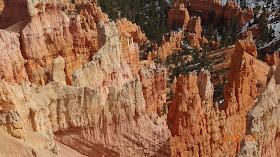Bryce Canyon National Park is located in the southwestern Utah in the USA. Bryce Canyon is known for its giant natural amphitheaters, made up of giant geological structures known as ‘Hoodoos’ (also known as tent rocks, fair chimneys, or earth pyramids). Hoodoos are tall, thin spire of rocks that protrude from the bottom of an arid drainage basin (or badlands). They range from 1.5 to 45 meters and typically consist of relatively soft rock topped by harder, less easily eroded stone that protects each column from the elements. They generally form within sedimentary rocks and volcanic rock formations. Hoodoos have variable thickness often described as having ‘totem-pole’ shaped body. These hoodoos are formed by frost weathering and stream erosion of the river and lake bed sedimentary rocks. The red, orange, and white colors of the rock provide spectacular views for the Park visitors.
Hoodoos don’t
grow like trees but are eroded out of the cliffs where rows of narrow walls
form. These thin walls of rock are called fins. Frost-wedging enlarges cracks
in the fins, creating holes or windows. As windows grow, their tops eventually
collapses, leaving a column. Rain further dissolves and sculpts these limestone
pillars into bulbous (fat, round, and bulging) spires called hoodoos. The
delicate climatic balance between snow and rain ensures that new hoodoos will
emerge while others become reduced to lumps of clay. Look at the pictures to understand
how the changes take place.
Technically, Bryce Canyon is not a
canyon. A series of Amphitheatres extend more than 20 miles north to south within
the Park, the largest of which is the Bryce Amphitheatre, which is 12 miles
long, 3 miles wide and 800 feet deep. Rainbow point (9105 feet elevation) is
the highest part of the Park.
Very little is known about the
inhabitation of the Park area. Archaeological surveys indicate that humans have
lived here for more than 10000 years. Artefacts of several thousand years old
belonging to the Basketmaker Ancestral Puebloans culture have been excavated in
the southern part of the Park. Other European and American explorations had
happened only during the 19th century.
The areas around the Bryce Canyon
became a National Monument in 1923 and became a National Park in 1928. In
comparison to Zion Canyon, the Park receives much fewer visitors, probably due
to remote location. Here too, there are a number of treks, some easy, some
moderately difficult, and some tough. The Sunrise and Sunset Points offer
fabulous views. I did the Queen’s Garden trek, a continuous descent of 357 ft
(1.8 miles round trip) through a paved trail. Some of the trails were closed
due to snowfall and ice formation. There are 13 viewpoints over the amphitheaters
along a scenic drive within the Park and 8 marked and paved hiking trails. The
Park has also 7.4 magnitude night sky, making it one of the darkest in North
America. Stargazers can, therefore, view 7500 stars with their naked eyes whereas
in most places only fewer than 2000 can be seen. Park Rangers hold public stargazing
events and evening programs.
Excepting at the Park’s lodges for
the inmates, we didn’t find any restaurants for food or beverages inside the
Park. Outside too, only the shops and restaurants belonging to the Locals were
found, and even they get closed quite early in the night. Subway was the only
eatery we found acceptable within a few miles distance from the Park-entrance.
Overall, our visit to Bryce Canyon
National Park was one of the most memorable ones. Here are the pictures taken
by me during the visit and they will speak for themselves about the stunning
beauty of the place.











No comments:
Post a Comment